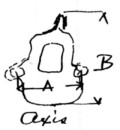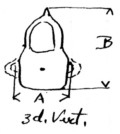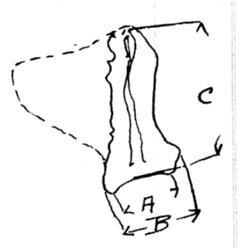This
year (2007) George, III found a Debit/Credit book that had been
discarded by the McKenna company after making some entries between
August 17, 1897, and June 30, 1898. Evidently, they found a more
efficient way of keeping track of cash flow ... there are only some
twenty handwritten lines. George, Sr. then used the book as his catalogue of specimens collected, starting with the Minooka mastodons. The catalog entries end on
August 19, 1919. That precipitous
curtailment may have taken place when George, Sr. finally sold the bones to the Field Museum.
What follows here is my transcript of George, Sr.'s
catalogue of
Minooka, Illinois, mastodon specimens that he collected and conserved.
|
|
Period
|
Location
|
Species
|
Pages
|
| Upper Pleistocene |
Minooka, Illinois
|
M. Americanus |
6-15
|
Parts of Head (pg.6)
Age
|
Code |
Description
|
Adult
|
Oc1
|
Posterior part head - including occipital, condyles & part parietal
|
Young
|
Oc5
|
Posterior part head - including 1/2 occipital, condyles, basis phenoid & part parietal
|
|
Jaws and Teeth Representing 11 Individuals (pp. 6 & 7)
Tooth measurements (in inches); see Figure 1.
|
Age
|
Code
|
Description
|
Notes
|
Teeth
Present
|
Teeth
Missing
|
Total
Teeth
|
1st
X
|
1st
Y
|
1st
Crests
|
2nd
X
|
2nd
Y
|
2nd
Crests
|
3rd
X
|
3rd
Y
|
3rd
Crests
|
Adult (?)
|
LMx1
|
Right maxillary
|
|
2
|
0
|
2
|
|
|
none
|
|
|
3
|
|
|
4+
|
Adult (?)
|
RM1
|
Right lower jaw, lacking chin and post. ramus & condyle
|
}Restored together
|
2
|
0
|
2
|
|
|
none
|
|
|
3
|
7-3/4
|
4-1/2
|
4+
|
Adult (?)
|
LM1
|
Left lower jaw, lacking chin and post. ramus & condyle |
}in anterior part
|
2
|
0
|
2
|
|
|
none
|
|
|
3
|
|
|
4+
|
Adult (?)
|
LMx2
|
Right maxillary lacking upper part
|
|
|
|
|
|
|
|
4-1/2
|
3-5/8
|
3
|
6-7/8
|
|
4
|
| Adult (?) |
RM2
|
Right lower jaw, post. ramus and candyle only
|
|
|
|
|
|
|
|
|
|
|
|
|
|
| Adult (?) |
LM2
|
Left lower jaw, complete
|
See Figure 2
for dimensions
|
2
|
0
|
2
|
|
|
|
|
|
3
|
|
|
4+
|
Adult
|
LMx6
|
Fragment left maxillary
|
See Figure 3
for side view
|
2
|
|
|
3-1/2
|
2-7/8
|
3
|
4-1/2
|
3-1/4
|
3
|
|
|
|
Medium
|
RM4
|
Right lower jaw, middle part only
|
|
2
|
1
|
3
|
|
|
|
4
|
2-7/8
|
3
|
5-1/8
|
3-1/2
|
3
|
| Medium |
LM4
|
Left lower jaw, anterior part only with fragment more posterior
|
|
1
|
2
|
3
|
|
|
|
4
|
2-7/8
|
3
|
|
|
|
| Medium |
LMx4
|
Fragment left maxillary
|
|
1
|
2
|
3
|
|
|
|
4
|
2-7/8
|
3
|
|
|
|
| Medium |
RMx4
|
Fragment right maxillary |
|
1
|
2
|
3
|
|
|
|
|
|
3
|
|
|
|
Young
|
RMx5
|
Fragment right maxillary |
|
3
|
0
|
3
|
2-7/8
|
2-1/8
|
3
|
3-5/8
|
2-1/2
|
3
|
4-1/4
|
3-1/4
|
3
|
| Young |
LMx5
|
Left maxillary
|
|
3
|
0
|
3
|
|
|
3
|
|
|
3
|
|
|
3
|
| Young |
LM5
|
Part middle part, lower jaw
|
|
2
|
1
|
3
|
|
|
|
|
|
3
|
|
|
3
|
| Young |
RM5
|
Part middle part, lower jaw |
|
3
|
0
|
3
|
|
|
3
|
|
|
3
|
|
|
3
|
Younger
|
LM3
|
Left lower jaw, lacking chin, post. ramus & candyle
|
}Restored together |
3
|
0
|
3
|
1-3/4
|
1-1/2
|
2
|
3-1/4
|
2-1/4
|
3
|
4
|
2-3/4
|
3
|
| Younger |
RM3
|
Right lower jaw, lacking chin, post. ramus & candyle |
}in anterior part |
|
|
|
|
|
2
|
|
|
3
|
|
|
3
|
Youngest
|
RM7
|
Right lower jaw, fragment
|
|
2
|
1
|
3
|
1-3/8
|
1-1/4
|
2+
|
2-1/8
|
1-3/4
|
3+
|
|
|
|
| Youngest |
LM8
|
Left lower jaw, fragment smaller than RM7
|
|
1
|
2
|
3
|
|
|
|
1-7/8
|
1-5/8
|
3+
|
|
|
|
|
|
One molar tooth, 3-3/4 by 3
|
|
|
|
|
|
|
|
|
|
|
|
|
|
|
|
One molar tooth, 3-1/2 by 2-1/8
|
|
|
|
|
|
|
|
|
|
|
|
|
|
|
Key to dimensional measurements: |
Tusks
(pg. 8)
|
Age
|
Code
|
Description
|
A dimension
|
B dimension |
C dimension |
D dimension |
Adult
|
LT1
|
Tusk complete
|
8 ft. 10 in.
|
19-1/2 in.
|
21-1/2 in.
|
5 ft.
|
| Adult |
RT1
|
Tusk posterior end
|
|
|
|
|
| Adult (?) |
T3
|
Tusk posterior end |
2 ft. 6 in.
|
20 in.
|
|
|
| Adult (?) |
T2
|
Tusk posterior middle part
|
3 ft. 8 in.
|
|
21 in.
|
|
Young
|
T4
|
Tusk nearly complete except near tip
|
5 ft.
|
|
13 in.
|
|
| Young |
T4
|
Tusk posterior end |
2 ft. 6 in.
|
12 in.
|
|
|
| Young |
T5
|
Tusk anterior end
|
2 ft. 1 in.
|
|
|
|
| Younger |
T6
|
Tusk anterior end |
1 ft. 4 in.
|
|
8 in. (one ft. from tip)
|
|
| Young |
T5
|
Tusk part anterior end |
1 ft. 3 in.
|
|
|
|
| Young |
T5
|
Tusk part anterior end |
|
|
|
|
| Young |
T5
|
Tusk part anterior end |
|
|
|
|
|
| Key to dimensional measurements:
|
Vertebrae
(pg. 9)
|
|











